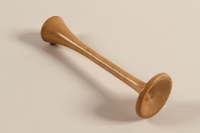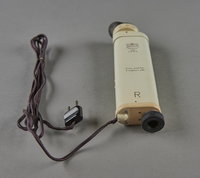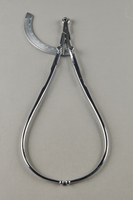Overview
- Brief Narrative
- Electrotherapy machine brought from Nazi Germany by Dr. Bruno Lambert, who immigrated to the United States in 1938, and served in the United States Army Medical Corps during the war. Electrotherapy involves using low-level electric currents to treat issues relating to the nervous or musculoskeletal systems. Bruno attended medical school in Germany from 1932-1937, but he was not allowed to receive a diploma as a Jew under the Nazi regime. He transferred to a university in Switzerland, and earned a Doctorate of Medicine in July 1938. With the help of Margaret Bergmann, Bruno immigrated to the US in August. Margaret was a Jewish athlete who was banned from competing in the Olympics by the Nazi authorities, and subsequently immigrated to the US. They had met at an athletic camp years prior and married after Bruno’s immigration. In the US, Bruno completed hospital internships and began practicing as a physician in New York City. In 1944, he became a naturalized citizen and a First Lieutenant in the Army Medical Corps. He deployed for France in October, and was awarded a Bronze Star for his war service. In the spring of 1945, Bruno spent a month and a half as a Medical Officer working with displaced persons (DPs) in Heidelberg, Germany. He returned to the United States in September 1945, and continued working in Army hospitals until the fall of 1946, when he retired from the military and entered private practice.
- Date
-
acquired:
1932-1945
- Geography
-
acquired:
Europe
manufacture: Germany
- Credit Line
- United States Holocaust Memorial Museum Collection, Gift of Bruno Lambert
- Markings
- a. interior, bottom left corner, circular tag, engraved : halle / EINGETR, SCHUTMARKE / MARQUE DEPOSEÉ / TRADE- MARK
a. interior base, bottom, separate metal tags, engraved : FARAD / Galvan. / Endosc. / kaustik
a. interior base, center switch, rectangular plate, engraved : F1 F2 / 3 mA 30
a. interior base, center dial, black ink, printed : 0 5 10 15 20 25 30 / 0 0.5 1 1.5 2 2.5 3 U/ mA
a. interior base, top, rectangular plate, engraved : Volt 100/130 131/170 200/240
a. interior left compartment, lid, underside, engraved : 5l
a. interior right compartment, lid, underside, engraved : 22883 / 5r
a. power plug, head, embossed : DURAFLEX / D.R.G.M / SSI 250 V.G.A. / VDE
a. power plug, head, center, embossed : manufacturing mark
a. power plug, paper tag, front, printed, black ink : Vor Anschluß an die Stedkdose: Nach-/ sehen, ob Apparat auf richtige Span-/ nung gestöpselt ist. / Avant de brancher la prise de courant / veiller à la tension exacte. / Before connecting with the electric / light plug, be sure to put the right tension.
a. power plug, paper tag, back, printed, black ink : Antes de poner el contacto con el / conector, buscar la tension conveniente. / Mettere nella giusta tensione prima / di immettere la spina nella controspina. / Antes de establecer o contacto, pro-/ curar a tensâo exacta. - Contributor
-
Subject:
Bruno B. Lambert
Manufacturer: Halle
- Biography
-
Bruno Bernhard Lambert (1910-2013) was born in Andernach, Germany, to Simon (1878-1942) and Lina (nee Löwensberg 1882-1942) Lambert. He had two younger siblings, Alfred (1911-2007) and Hannah (later Myers, 1913-1993). Simon worked as a butcher, and the family was integrated into the larger German community. They observed the Jewish holidays, but did not keep up with orthodox practices. As a child, Bruno was very active in athletics and experienced no antisemitism.
Bruno graduated from high school in 1931, and began studying medicine at the University of Bonn the following year. On January 30, 1933, Adolf Hitler was appointed chancellor of Germany by President Paul von Hindenburg. Under Hitler, authorities quickly began suppressing the rights and personal freedoms of Jews, and boycotting their businesses. At the university, Jewish students were deemed “aliens,” and were no longer eligible to receive diplomas. Since Bruno’s father had served in the German army during World War I, he was allowed to continue his studies, but could not receive a diploma or practice medicine. He was also banned from his athletic organizations.
In the year leading up to the 1936 Berlin Olympics, Bruno was invited to participate in a Jews-only training camp, though he was not an Olympic-caliber athlete. The camp was part of the Nazi regime's propaganda effort to show the world Germany did not discriminate against Jews. While there, he became friends with Margarethe (Gretel) Bergmann (1914-2017), a track and field athlete who had previously won championships in Germany and Great Britain for high jump. Although Gretel tied the German national record for the high jump and could have won a gold medal, the Nazi authorities stripped her of the record and did not let her compete in the Olympics. Gretel immigrated to the United States in May 1937 and Americanized her name to Margaret. Bruno left the University of Bonn in July 1937, and enrolled at the University of Bern in Switzerland with his friend, Herbert Myers (1914-1918), who married his sister. He received his Doctorate of Medicine from the University of Bern in July 1938. Shortly thereafter, Bruno immigrated to the United States, and arrived in New York City on August 3, 1938. He was sponsored by Margaret, and the two married in September. Bruno first started working as an interior painter, but quit soon after because he was able to obtain an internship at Wyckhoff Heights Hospital in Queens. Bruno was the first international and married intern to work there. The hospital had several German nurses who helped him learn English while on the job.
On November 9, 1938, two months after Bruno left Germany, the Kristallnacht pogrom targeted Jewish communities across the Reich, destroying stores and burning synagogues. Following Kristallnacht, Bruno’s brother, Alfred, and brother-in-law, Herbert Myers, were among the thousands of Jewish men arrested by the Gestapo and imprisoned in Dachau. They were released after a month, and left Germany for Shanghai, China, intending to continue on to the United States. Bruno’s parents also intended to immigrate to the United States, but were not able to get out. Simon and Lina were deported to Poland sometime between April 1940 and April 1941, where they were likely killed.
Bruno registered for the draft in October 1940, but could not enlist until he received citizenship papers. In November 1941, Bruno became a resident physician at Triboro Hospital, a new tuberculosis hospital in Queens, and was promoted to Chief Resident in January 1943. Bruno became a naturalized citizen on February 1, 1944, and immediately enlisted as an officer in the army. He attended the Medical Field Service School from May until June 1944, and was then assigned to the 410th Infantry, 103rd Division as a First Lieutenant. His unit deployed for Europe on October 6, 1944, and arrived in Marseilles, France, on October 20.
In December 1944, Bruno was awarded the Bronze Star for meritorious service while under fire, and in January, he was promoted to Captain. In late March 1945, Bruno was detached from the 328th Medical Battalion to work as a Medical Officer with displaced persons (DPs) in Heidelberg. After a month and a half, he had a succession of assignments with the 928th, 171st, and the 158th Field Artillery Battalions, as part of the occupational forces after Germany surrendered on May 7, 1945. Bruno was supposed to redeploy to the Pacific, and was awaiting a transport in France when Japan surrendered on August 14. He departed Europe for the United States on September 4, 1945.
After returning home, Bruno was assigned to the hospital at Camp Bowie, Texas, and reassigned in January 1946 to an army hospital in Santa Fe, New Mexico. In September, Bruno and Margaret returned to New York, where he opened a private practice. After the war, Bruno learned that his siblings had survived in Shanghai, and he was able to bring his brother Alfred to the United States in February 1947. His sister Hannah, and brother-in-law Herbert, were also able to immigrate to the United States, and settled in Providence, Rhode Island. Bruno was formally relieved from active duty on November 17, but remained in the Officers’ Reserve Corps, where he was promoted to Major in March 1947. The following month, their first son, Glenn, was born; their second son, Gary, was born in March 1951. In December 1952, Bruno was honorably discharged from the Reserves.
Physical Details
- Classification
-
Tools and Equipment
- Category
-
Medical equipment
- Object Type
-
Electrotherapy--Instruments (lcsh)
- Genre/Form
- Medical equipment & supplies.
- Physical Description
- The a - c component designations have been added for cataloging purposes only. The b & c components are store inside a.
a. Heavy, rectangular electrotherapy machine in a wooden housing covered with black treated paper. It has a hinged lid, a black leather handle, and 2 draw bolts on the front, and foot studs on the bottom. All metal elements are silver colored and all plastic is black. The interior base is covered by a rectangular panel of pearled plastic, it has a large front area with 2 smaller compartments behind. The large section has 6 threaded metal tubes, inputs, with ridged plastic rings, in pairs. Between the left inputs is a plastic knob above an oval window displaying negative and positive symbols. Above the inputs is a row of 4 plastic knobs with engraved white painted numbers 0 to 10 around the base and uppercase letters on top: F and G on the left, K in the center, and E on the right. Above the knobs is a row of 3 plastic switches. Above the center switch is a white dial with a needle covered by clear glass in a metal ring, with a small, red painted glass lightbulb above. To the left is a raised metal ring with 2 copper wire rolls inside, covered with translucent yellow plastic with a knob in the center. To the right is a thin, flat, engraved label riveted above 3 holes, with a metal rod topped by a plastic knob in the left hole. The back compartments are covered by hinged panels with metal knobs. The left compartment stores additional machine parts and the right stores the attached plastic coated electrical cord with a 2 prong, circular plug. A paper tag is attached to the cord. The lid is lined with treated black paper.
b. Metal electrical wire wrapped in faded green cloth for use with electrotherapy machine (a). A silver colored metal tube with ridged sides and a narrow needle with a rounded tip is attached to both ends of the wire.
c. Metal electrical wire wrapped in faded red cloth for use with electrotherapy machine (a). A silver colored metal tube with ridged sides and a narrow needle with a rounded tip is attached to both ends of the wire. - Dimensions
- a: Height: 6.000 inches (15.24 cm) | Width: 16.750 inches (42.545 cm) | Depth: 13.750 inches (34.925 cm)
b: Height: 50.125 inches (127.318 cm) | Diameter: 0.250 inches (0.635 cm)
c: Height: 49.875 inches (126.683 cm) | Diameter: 0.250 inches (0.635 cm) - Materials
- a : wood, metal, plastic, paper, glass, paint, ink, copper, string
b : metal, cloth
c : metal, cloth
Rights & Restrictions
- Conditions on Access
- No restrictions on access
- Conditions on Use
- No restrictions on use
Keywords & Subjects
- Topical Term
- German American soldiers--Biography. Holocaust, Jewish (1939-1945)--Germany--Personal narratives. Jewish refugees--United States--Biography. Jewish soldiers--United States--Biography. Jews--Persecution--Germany--Biography. Soldiers--United States--Biography. World War, 1939-1945--Personal narratives. Germany--Emigration and immigration--Biography. United States--Emigration and immigration--Biography. Electrotherapy--Machines.
- Geographic Name
- Andernach (Germany) Bern (Switzerland) Bonn (Germany) France. Germany. New York (N.Y.)
- Personal Name
- Bergmann, Gretel, 1914-2017.
- Corporate Name
- Universität Bern Universität Bonn United States. Army. Medical Corps
Administrative Notes
- Legal Status
- Permanent Collection
- Provenance
- The electrotherapy machine was donated to the United States Holocaust Memorial Museum in 2003 by Dr. Bruno Lambert.
- Funding Note
- The cataloging of this artifact has been supported by a grant from the Conference on Jewish Material Claims Against Germany.
- Record last modified:
- 2023-08-28 07:52:59
- This page:
- https://collections.ushmm.org/search/catalog/irn135414
Download & Licensing
In-Person Research
- By Appointment
- Request 21 Days in Advance of Visit
- Plan a Research Visit
- Request to See This Object
Contact Us
Also in Bruno Lambert collection
The collection consists of calipers, a stethoscope, a retinoscope, an electrotherapy machine, and documents relating to the experiences of Bruno Lambert, who left Germany in 1937 for the United States and later served in the Army Medical Corps and with the 123rd Infantry during World War II. Some of these materials may be combined into a single collection in the future.
Date: 1943-1945

Monaural wooden stethoscope used by a Jewish German refugee and US Army medic
Object
Wooden Pinard fetal stethoscope (or fetoscope) used by Dr. Bruno Lambert, who immigrated to the United States from Nazi Germany in 1938, and served in the United States Army Medical Corps during the war. The Pinard stethoscope was designed in 1895, and is an efficient, low-cost way to hear babies’ heartbeats while in utero. Bruno attended medical school in Germany from 1932-1937, but he was not allowed to receive a diploma as a Jew under the Nazi regime. He transferred to a university in Switzerland, and earned a Doctorate of Medicine in July 1938. With the help of Margaret Bergmann, Bruno immigrated to the US in August. Margaret was a Jewish athlete who was banned from competing in the Olympics by the Nazi authorities, and subsequently immigrated to the US. They had met at an athletic camp years prior and married after Bruno’s immigration. In the US, Bruno completed hospital internships and began practicing as a physician in New York City. In 1944, he became a naturalized citizen and a First Lieutenant in the Army Medical Corps. He deployed for France in October, and was awarded a Bronze Star for his war service. In the spring of 1945, Bruno spent a month and a half as a Medical Officer working with displaced persons (DPs) in Heidelberg, Germany. He returned to the United States in September 1945, and continued working in Army hospitals until the fall of 1946, when he retired from the military and entered private practice.

Electric retinoscope used by a Jewish German US Army medic
Object
Retinoscope used by Dr. Bruno Lambert, who immigrated to the United States from Nazi Germany in 1938, and served in the United States Army Medical Corps during the war. Retinoscopes light the internal eye, allowing a doctor to measure how the retina reflects light. Bruno attended medical school in Germany from 1932-1937, but he was not allowed to receive a diploma as a Jew under the Nazi regime. He transferred to a university in Switzerland, and earned a Doctorate of Medicine in July 1938. With the help of Margaret Bergmann, Bruno immigrated to the US in August. Margaret was a Jewish athlete who was banned from competing in the Olympics by the Nazi authorities, and subsequently immigrated to the US. They had met at an athletic camp years prior and married after Bruno’s immigration. In the US, Bruno completed hospital internships and began practicing as a physician in New York City. In 1944, he became a naturalized citizen and a First Lieutenant in the Army Medical Corps. He deployed for France in October, and was awarded a Bronze Star for his war service. In the spring of 1945, Bruno spent a month and a half as a Medical Officer working with displaced persons (DPs) in Heidelberg, Germany. He returned to the United States in September 1945, and continued working in Army hospitals until the fall of 1946, when he retired from the military and entered private practice.

Pelvic calipers used by a Jewish German US Army medic
Object
Calipers brought from Nazi Germany by Dr. Bruno Lambert, who immigrated to the United States in 1938, and served in the United States Army Medical Corps during the war. Medical calipers were used to measure the thickness or breadth of a part of the body. Bruno attended medical school in Germany from 1932-1937, but he was not allowed to receive a diploma as a Jew under the Nazi regime. He transferred to a university in Switzerland, and earned a Doctorate of Medicine in July 1938. With the help of Margaret Bergmann, Bruno immigrated to the US in August. Margaret was a Jewish athlete who was banned from competing in the Olympics by the Nazi authorities, and subsequently immigrated to the US. They had met at an athletic camp years prior and married after Bruno’s immigration. In the US, Bruno completed hospital internships and began practicing as a physician in New York City. In 1944, he became a naturalized citizen and a First Lieutenant in the Army Medical Corps. He deployed for France in October, and was awarded a Bronze Star for his war service. In the spring of 1945, Bruno spent a month and a half as a Medical Officer working with displaced persons (DPs) in Heidelberg, Germany. He returned to the United States in September 1945, and continued working in Army hospitals until the fall of 1946, when he retired from the military and entered private practice.



